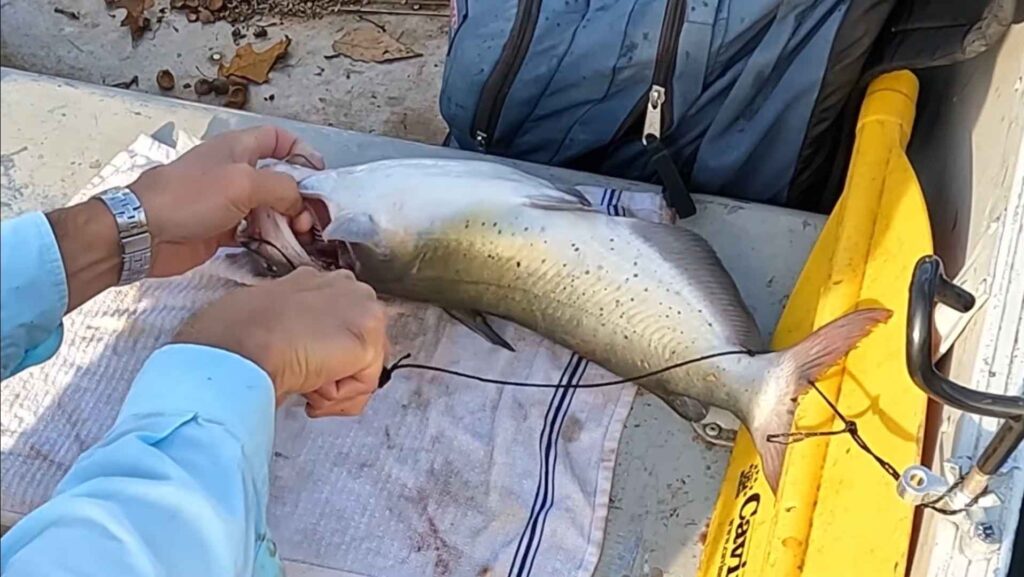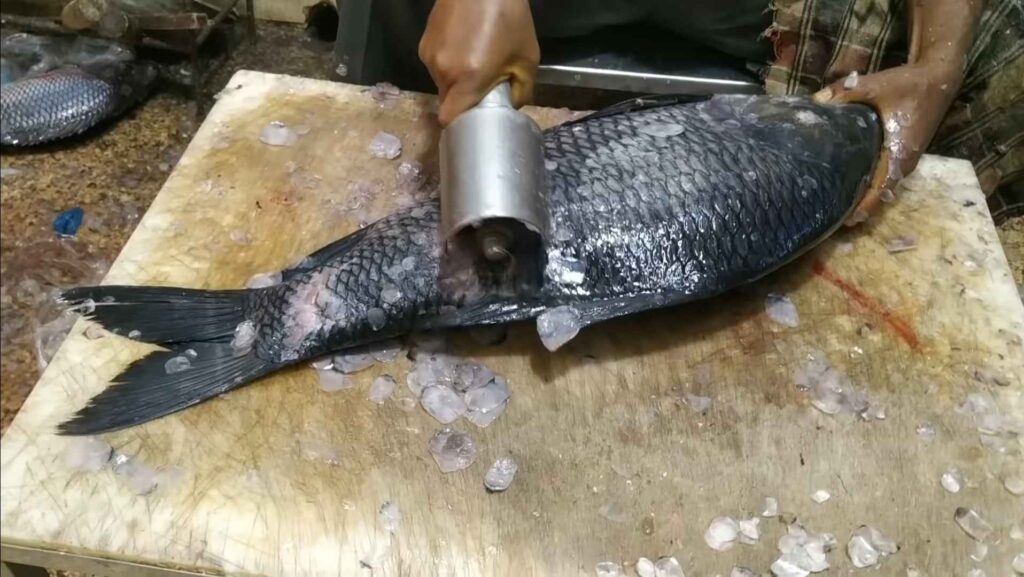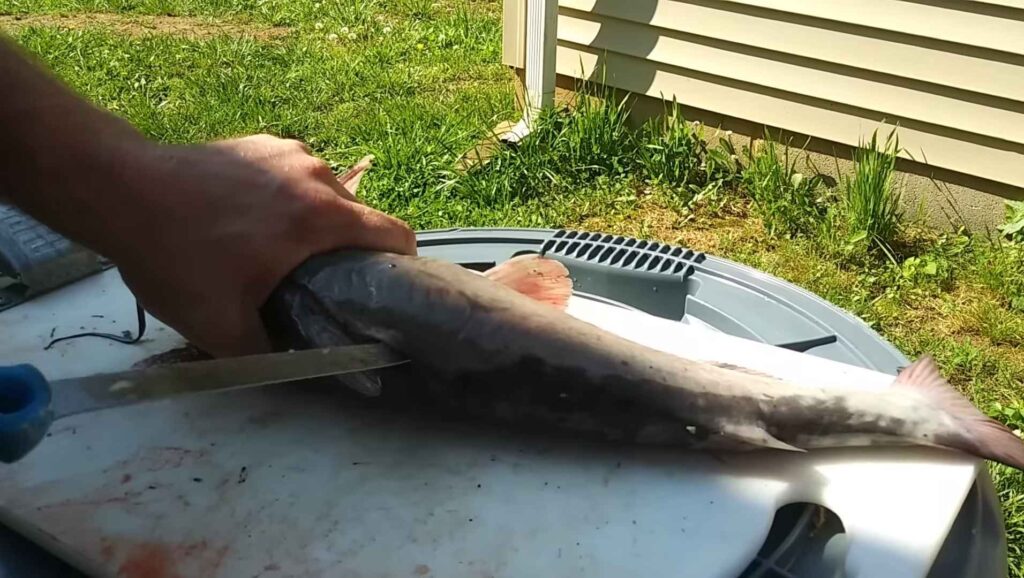To fillet a catfish with an electric knife, first prepare the area. Make sure you have a cutting board and access to running water. Put on gloves if desired.
Then, turn the fish over onto its back and make a cut along the length of its belly using your electric knife. Using your fingers or scissors, remove all of the organs from inside the stomach cavity and discard them into a separate bowl.
Cut off both sides of the head as close to the body as possible, then locate where it’s backbone meets its tail fin; this is where you will begin cutting out each side of meat from either side of it spine in one continuous motion until reaching its tail fin.
Rinse off any blood or slime before adding seasoning or cooking your fillets!
- Step 1: Gather the necessary supplies
- To fillet a catfish with an electric knife, you will need an electric knife, a cutting board, a pair of kitchen scissors, and some paper towels.
- You may also want to have some running water handy in case your hands get slippery.
- Step 2: Clean and prepare the catfish
- Rinse off the catfish with cold water to remove any dirt or debris from its body and scales.
- Use paper towels to dry it off before proceeding further.
- Step 3: Place the catfish on a cutting board and hold it steady with either one hand or two
- With your other hand, insert the electric knife blade into the fish just behind its head at an angle of approximately 45 degrees away from you so that it slides easily along its back as you cut downward towards its tail fin (as if peeling away).
- Make sure that your knife is pointed toward where you want to make your cuts for safety reasons; never point it directly toward yourself!
- Step 4: Cut along both sides of each rib bone until all meat has been separated from them
- If there are still bones attached to any pieces of meat after this step, use kitchen scissors to snip them free and discard them accordingly afterward
- Step 5: Remove Pieces
- Once all bones have been removed from each piece of filleted flesh, feel free to trim up any edges using either kitchen scissors or the electric knife again if needed for presentation purposes–this step is entirely optional, depending upon how precise you’d like your final product to be!

Can You Use an Electric Knife to Fillet Fish?
Yes, you can use an electric knife to fillet fish. Electric knives are great for the job since they make it easier and faster than a regular kitchen knife.
Using an electric knife to fillet fish is a great way to get perfectly even slices with minimal effort while also minimizing waste due to its precise cutting ability.
To begin, make sure that your electric knife is clean and dry before starting the process of filleting your fish. Make sure all scales have been removed from the fish’s skin as well, then position it on a flat surface like a cutting board or plate.
Start by making shallow cuts along one side of the spine until you reach the tail, then turn over and cut along the bone on the other side to remove both filets at once without damage or tearing either piece apart.
Once everything has been cleaned up properly with no bones remaining in each slice of meat, you’re ready to enjoy your perfectly prepared meal!
How Do You Fillet a Catfish With a Knife?
Filleting a catfish with a knife is not as daunting as it may sound. The process begins by prepping the fish, which includes scaling and cleaning the fish. Once that is done, you can begin filleting the catfish.
The best way to do this is to make a straight cut behind the gills of your catfish down to its tail end, avoiding cutting into its stomach cavity or other organs.
Then start making cuts near the spine, working towards one side until you reach where your first cut ended at its tail end; again, avoid any organs within.
You can now flip over your fish and repeat on the other side to remove both filets from either side of your catfish’s body simultaneously.
Finally, run your knife gently along each filet’s skin before removing it completely from both sides for perfectly boneless fillets every time!
Can You Use Electric Carving Knife on Fish?

Yes, you can use an electric carving knife on fish. This is a great tool for cutting up delicate and fine-textured fish such as salmon or trout. An electric carving knife has adjustable blades that make it easy to get the perfect cut every time.
The powerful motor also makes slicing through the skin and flesh of a large fish easier than with a traditional kitchen knife. Additionally, because an electric carving knife only requires one hand to operate, it leaves your other hand free to hold the fish in place while you carve it into sections or slices.
When using an electric carving knife to prepare fish, keep safety in mind by unplugging the device when not in use and keeping small hands away from moving parts during operation.
How Do You Fillet Catfish Without Skinning?

Filleting catfish without skinning is a great way to enjoy the full flavor of the fish. The process can be done using just your hands and a sharp fillet knife, and it’s fairly simple. First, lay the catfish on its back with its head facing away from you.
Make sure it’s firmly in place so it doesn’t move while cutting. Next, incision near the gills and cut along one side of the backbone until you reach its tail fin.
Once this is done, turn your knife slightly outward and carefully slide it down towards the belly as far as possible without piercing through any bone or organs attached to it.
Finally, slowly pull up on both sides of the fillet while keeping constant pressure on them with your free hand to separate them before removing them from either side of the ribcage area by gently pulling them apart at joints connected to those areas if necessary.
Doing this will prepare two beautiful pieces of boneless catfish for cooking!
How to Bleed & Fillet a Catfish with an Electric Knife / No Waste /
How to Fillet a Catfish
Filleting a catfish is a simple process that anyone can do with the right tools. Start by cleaning the fish and removing its scales, then cut along its backbone from head to tail. Using a sharp knife, carefully run it along either side of the spine, separating the flesh from bone.
Finally, remove any remaining bones using tweezers or needle-nose pliers before serving your delicious fillet!
How to Bleed a Channel Catfish
Bleeding a channel catfish is an important step in maintaining its quality and freshness. To do this, insert the knife into the fish’s gill slit and cut it open along the length of its body. Then, use your thumb to press against the spine to separate it from flesh.
You can then run water over the exposed vertebrae or submerge it in a bucket of cold water for several minutes to help release any remaining blood from veins and arteries inside of its body cavity. This process ensures that your catch will remain safe and delicious when consumed later on!
What Makes Catfish Meat Yellow?
Catfish meat is a popular seafood dish known for its yellow color and mild flavor. The yellow hue of catfish comes from the presence of carotenoids in their diet, which are natural pigments found in certain plants and algae that give orange-red colors to animals like cats. These carotenoids are passed on to humans when they consume the fish, giving it an attractive golden-yellow color.
How to Remove Mud Vein from Catfish?
Cleaning mud vein from catfish can be a tricky process, but it is essential in order to avoid any off flavors or food-borne illnesses.
Before filleting the fish, you should use a pair of pliers or tweezers to pull out any visible veins that the cleaning process may have left behind. Once all the veins have been removed, rinse the filets and pat them dry with paper towels before cooking.
How to Bleed Snook
Bleeding snook is an essential process for anglers to understand when planning a fishing trip. Bleeding your catch requires cutting the gill plates behind the operculum and allowing blood to escape from the body cavity, which should be done immediately after catching a snook.
This helps ensure fresher-tasting meat by removing any contaminants or bacteria in the bloodstream, improving overall flavor.
Additionally, bleeding will help preserve the color of your catch and improve its shelf life in case it’s not consumed immediately.
Purging Catfish
Purging catfish is a common practice in the aquaculture industry and involves removing all of the fish from a tank or pond, cleaning it out, and then restocking with new fish. This process helps to reduce overcrowding, improve water quality, and prevent disease outbreaks by allowing for more efficient filtration systems.
Purging can also help increase overall fish health by reducing competition between species and providing them with better nutrition due to improved water conditions.
Why is My Catfish Meat Red?
Catfish meat is red because it contains an abundance of myoglobin, a protein that stores oxygen in the muscle tissue. Myoglobin turns red when exposed to air and heat, so cooking catfish causes it to turn its signature pinkish-red hue. The amount of myoglobin present also varies based on age and fish species, with older catfish containing more than younger ones.
Bad Tasting Catfish
Catfish can taste bad for many reasons, but the most common is due to toxins in their diet. Catfish feed on bottom-dwelling organisms that accumulate pollutants like heavy metals and pesticides from polluted waters. When we eat these fish, these pollutants are passed along to humans, resulting in a significantly unpleasant tasting experience.
Additionally, catfish stored improperly or kept out of water too long can spoil quickly and result in an off taste.
Conclusion
In conclusion, catfish filleting with an electric knife can be a time-saving and mess-free way to enjoy your catch. With the right tools and technique, you can quickly have delicious catfish ready for cooking.
The process is simple and requires just a few steps: cutting off the head, slicing along the backbone, removing the ribs from each side of the fish, and then making cuts to separate out individual fillets.
With practice, you’ll soon become proficient in this easy method of filleting catfish!